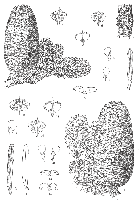
Line drawing; for full size image go to the Flora of China (Wu and Raven 1999).
Abies fargesii var. faxoniana
岷江冷杉 min jiang leng shan (Wu and Raven 1999), Faxon fir (Silba 1986).
Syn: A. delavayi var. faxoniana Jackson; A. faxoniana Rehder et Wilson (Farjon 1990).
A conical tree 20-40 m tall, to 1.5 m in girth, with horizontal branches. Bark dark grey and smooth, becoming fissured. Branchlets slightly grooved, slightly pubescent, red-brown or grey, turning yellow. Buds ovoid, apex obtuse, purple-brown, resinous, 8-9 mm in diameter. Leaves irregularly spreading, grooved and bright yellow-green without stomata above; green-white below with stomata in 8-14 lines; 10-35 mm long by 2-2.5 mm wide, nearly 2-ranked, straight or slightly curved, apex rounded or finely notched. Male cones red, to 10 mm long. Female cone broadly rounded, apex with a blunt point, ovoid or oblong, somewhat resinous, violet-purple or dark blue, 5-9 cm long by 3.5-4 cm wide; bracts exserted and reflexed, relatively narrow, somewhat spathulate. Seeds with a dark brown-purple nut and black to purple wing, 13-20 mm long (Silba 1986).
Distinguished from the type variety by having light brown or gray-brown first-year branchlets. The main branchlets are glabrous, but there is a dense rusty brown pubescence on the lateral branchlets (Wu and Raven 1999).
NE Burma; China: C Gansu, NW Sichuan. At 2600-4000 m altitude with an optimum between 3400-3800 m (Wang 1961).
Studies of forest regeneration at the Sichuan Wanglang National Nature Reserve describe mixed forests of A. fargesii var. faxoniana with Picea purpurea and Betula sp. over a dense shrub bamboo understory. All canopy species regenerate in canopy gaps, with the Abies preferring soil substrates and the Picea mainly found on down wood. Strategies for species persistence appeared to include rare pulses of abundant Abies establishment, with persistence of Picea due to high survivorship and greater age (Taylor et al 2006). This pattern is also seen in other closed-canopy Abies-Picea forests, e.g. in Abies amabilis-Picea sitchensis and Abies lasiocarpa-Picea engelmannii forests in North America (pers. obs.), and in Abies sachalinensis-Picea glehnii forest of Japan (Takahashi 1994, 1997).
The conservation status of this variety has not been assessed by the IUCN, which has assessed A.fargesii as "Least Concern".
Ages of more than 350 years, based on ring counts from increment cores, are reported by Taylor et al. (2006).
No data as of 2023.02.22.
No data as of 2023.02.22.
Named for Charles Edward Faxon (1846-1918), a superlative American botanical illustrator, best known for illustrating Sargent's publications, including his Forest Flora of Japan and Silva of North America.
Farjon, Aljos. 1990. Pinaceae: drawings and descriptions of the genera Abies, Cedrus, Pseudolarix, Keteleeria, Nothotsuga, Tsuga, Cathaya, Pseudotsuga, Larix and Picea. Königstein: Koeltz Scientific Books.
Takahashi, L. 1994. Effect of size structure, forest floor type, and disturbance regime on tree species composition in a coniferous forest in Japan. Journal of Ecology 82:769–773.
Takahashi, K. 1997. Regeneration and coexistence of two subalpine conifer species in relation to dwarf bamboo in the forest understory. J. Veg. Sci. 8:529–536.
Taylor A.H., Shi Wei Jang, Lian Jun Zhao, Chun Ping Liang, Chang Jin Miao, and Jinyan Huang. 2006. Regeneration patterns and tree species coexistence in old-growth Abies–Picea forests in southwestern China. Forest Ecology and Management 223:303–317.
The species account at Threatened Conifers of the World.
Cheng and Fu (1978) (as A. faxoniana).
Last Modified 2023-02-26